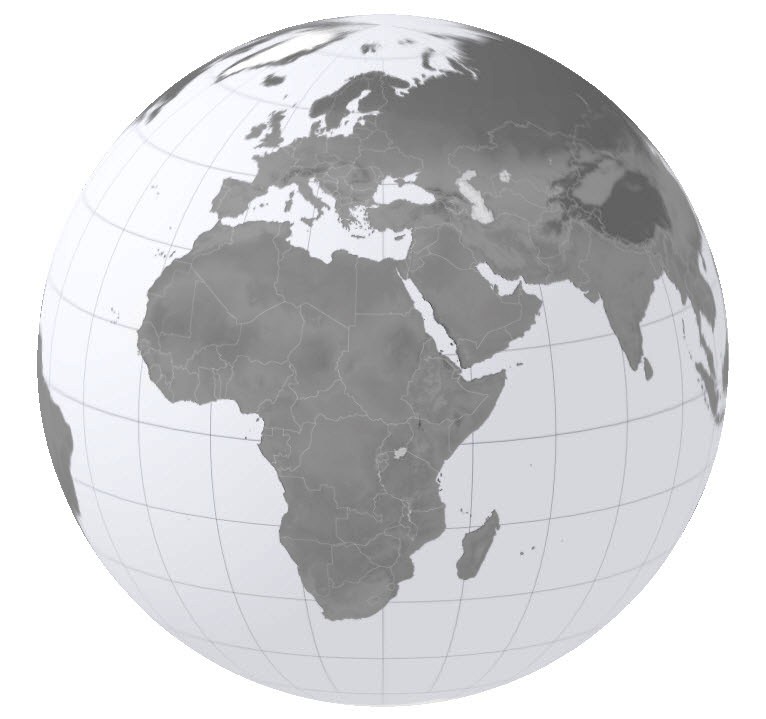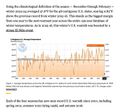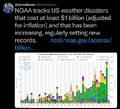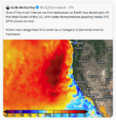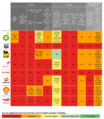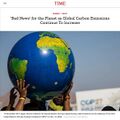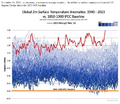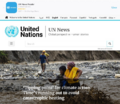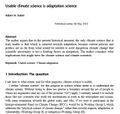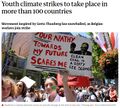Category:Climate Migration
<addthis />
- 2023
Rising Seas threaten 'mass exodus' on a 'biblical scale'
An increase in the pace at which sea levels are rising threatens “a mass exodus of entire populations on a biblical scale”, the UN secretary general has warned.
The climate crisis is causing sea levels to rise faster than for 3,000 years, bringing a “torrent of trouble” to almost a billion people, from London to Los Angeles and Bangkok to Buenos Aires, António Guterres said on Tuesday. Some nations could cease to exist, drowned under the waves, he said.
Addressing the UN security council, Guterres said slashing carbon emissions, addressing problems such as poverty that worsen the impact of the rising seas on communities and developing new international laws to protect those made homeless – and even stateless – were all needed. He said sea level rise was a threat-multiplier which, by damaging lives, economies and infrastructure, had “dramatic implications” for global peace and security.
Significant sea level rise is already inevitable with current levels of global heating, but the consequences of failing to tackle the problem are “unthinkable”. Guterres said: “Low-lying communities and entire countries could disappear for ever. We would witness a mass exodus of entire populations on a biblical scale. And we would see ever fiercer competition for fresh water, land and other resources...
🌎
2022
Map of Hope and Sorrow
Award-winning author Helen Benedict and Syrian writer and refugee Eyad Awwadawnan team up to present the intimate stories of refugees from the Middle East and Africa who fled violence or persecution only to become trapped in some of the world’s worst refugee camps in Greece. Both authors spent years getting to know the interviewees and winning their trust. The result is five powerful stories of resilience, suffering and hope. Hasan, Asmahan, Evans, Mursal and Calvin each tell their story in their own words, retaining control and dignity, while revealing intimate and heartfelt scenes from their lives. They describe their homes and families in Syria, Nigeria, Afghanistan or Cameroon; their arduous journeys of escape; and recount how they ended up trapped in the Europe they believed would give them freedom, only to be abused and reviled.
○
Where We'll End Up Living as the Planet Burns
By Gaia Vince
Adapted from Gaia Vince’s new book NOMAD CENTURY: How Climate Migration Will Reshape Our World, published by Flatiron Books (August 2022)
While nations are trying to cut their carbon emissions and adapt to warmer climates, the elephant in the room is that for large parts of the globe, the local conditions are too extreme. There is no other way of adapting. To survive, people will need to relocate.
The next 50 years will see increased heat, combined with greater humidity, make huge swathes worldwide uninhabitable. Massive numbers will have to flee from the tropics, coasts, and former arable lands. You will either be one of them or they will give you housing. This migration has already begun—we have all seen the streams of people fleeing drought-hit areas in Latin America, Africa, and Asia where farming and other rural livelihoods have become impossible.
Over the past decade, global migration has increased by two-thirds. The issue of dealing with the rapidly rising number of refugees will be more important as the earth heats.
We can—and we must—prepare. A radical plan to ensure humanity’s survival in a hotter world involves building new large cities to the far north and abandoning vast areas of the unsustainable tropics. This involves adapting food, energy and infrastructure to the changing environment. As billions are forced from their homes, they will need new housing.
Cooperating like never before is our best chance of success: dissociating the political map and geography. It may sound absurd, but we must look at the world from a new perspective and create plans that are based on geography, ecology, and geology. In other words: identify the areas with the greatest freshwater supply, safe temperatures, solar energy sources, and plan for population growth, food, and energy production. The good news is, there’s plenty of room on Earth...
🌎
Climate Refugees, Climate-Related Migrants
- By 2050 over one billion people are at threat of being displaced
- Drought, war, civil violence, economic disruption -- the costs of climate change are coming into view
Climate change is the defining crisis of our time and disaster displacement one of its most devastating consequences. Entire populations are already suffering the impacts, but vulnerable people living in some of the most fragile and conflict-affected countries are often disproportionately affected.
Refugees, internally displaced people (IDPs) and the stateless are on the frontlines of the climate emergency. Many are living in climate “hotspots”, where they typically lack the resources to adapt to an increasingly hostile environment.
The United Nations High Commissioner for Refugees (UNHCR) has issued warnings, “Urgent steps needed now to mitigate climate impact on displaced people”. They continued: “The climate crisis is a human crisis. It is driving displacement and makes life harder for those already forced to flee.”
UN Global Refugees Social Media Accounts
(2020)
Climate crisis could displace 1.2bn people by 2050, report warns
The Institute for Economics and Peace (2020): Over one billion people are at threat of being displaced by 2050 due to environmental change, conflict and civil unrest.
The Ecological Threat Register measures ecological threats countries are currently facing and provides projections to 2050. The report combines measures of resilience with the most comprehensive ecological data available, to shed light on the countries least likely to cope with extreme ecological shocks.
Key results
- 19 countries with the highest number of ecological threats are among the world's 40 least peaceful countries including Afghanistan, Syria, Iraq, Chad, India and Pakistan.
- Over one billion people live in 31 countries where the country's resilience is unlikely to sufficiently withstand the impact of ecological events by 2050, contributing to mass population displacement.
- Sub-Saharan Africa, South Asia, the Middle East and North Africa are the regions facing the largest number of ecological threats.
- By 2040, a total of 5.4 billion people – more than half of the world's projected population – will live in the 59 countries experiencing high or extreme water stress, including India and China.
- 3.5 billion people could suffer from food insecurity by 2050; which is an increase of 1.5 billion people from today.
- The lack of resilience in countries covered in the ETR will lead to worsening food insecurity and competition over resources, increasing civil unrest and mass displacement, exposing developed countries to increased influxes of refugees.
🌎
Visions of Humanity
A composite index measuring the impact of ecological threats to countries made up of 5 qualitative indicators each weighed on a scale of 1-5. The higher the score, the more at risk the country.
The second edition of the Ecological Threat Report (ETR), which analyses 178 independent states and territories. Produced by the Institute for Economics and Peace (IEP), the report covers over 2,500 sub- national administrative units or 99.9% of the world’s population.
🌎
Climate refugee or climate migrant?
- https://yorkshirebylines.co.uk/news/environment/climate-migration-and-climate-change/ Via Yorkshire Bylines]
The terms refugee and migrant have been repeatedly used as political weapons by various political parties and governments, and the connotations of these labels can be contentious. The term ‘refugee’, according to the 1951 UN Convention Relating to the State of Refugees, is “someone who is unable or unwilling to return to their country of origin owing to a well-founded fear of being persecuted for reasons of race, religion, nationality, membership of a particular social group, or political opinion”.
The Intergovernmental Panel on Climate Change (IPCC) warns that language is important in order to offer legal protection to individuals. They caution that:
“This is not just semantics—which definition becomes generally accepted will have very real implications for the obligations of the international community under international law. Forced climate migrants fall through the cracks of international refugee and immigration policy—and there is considerable resistance to the idea of expanding the definition of political refugees to incorporate climate ‘refugees’. The term ‘climate migrant’ can also be a loaded term, with the implication that the ‘pull’ of the destination rather than the ‘push’ of the original country is the primary factor for an individual to move.”
In its conclusion, they note that formal recognition is the critical first step.
“Meanwhile, large-scale migration is not taken into account in national adaptation strategies which tend to see migration as a ‘failure of adaptation’. The international community needs to acknowledge formally the predicament of forced climate migrants.”
The IPCC also highlight that numbers of displaced persons may be significantly under-counted owing to large-scale displacement within countries. “Given that the majority of people displaced by climate change will likely stay within their own borders, restricting the definition to those who cross international borders may seriously understate the extent of the problem”. National borders may seriously understate the extent of the problem”.
...with the lack of a secure definition under international law, climate migrants can fall between the cracks in asylum law, with no institution or country responsible for providing them with basic services. This, in turn, has the potential to be the biggest humanitarian disaster ever recorded – with hundreds of millions of people at risk of climate displacement.
🌎
Millions of People May Soon Become Climate Migrants
Climate change will drive human migration more than other events, a new report warns. But the worst impacts can be avoided.
National Geographic / World Bank / March 2018
Climate change will soon transform more than 143 million people into “climate migrants” (#ClimateMigration) escaping crop failure, water scarcity, and sea-level rise, a new World Bank report concludes.
Most of this population shift will take place in Sub-Saharan Africa, South Asia, and Latin America—three “hot spots” that represent 55 percent of the developing world’s populations.
The report, Groundswell—Preparing for Internal Climate Migration, also shifts the focus from cross-border migration, which has drawn global attention as refugees and migrants flee war, poverty and oppression, to in-country migration, which involves many more millions of people on the move in search of viable places to live.
○
Pages in category "Climate Migration"
The following 20 pages are in this category, out of 20 total.
C
E
G
Media in category "Climate Migration"
The following 124 files are in this category, out of 365 total.
(previous page) (next page)- Michael E Mann, act with hope not fear.jpg 1,246 × 1,772; 256 KB
- Michael Mann - Susan Joy Hassol after Glasgow.jpg 460 × 1,616; 299 KB
- Mick stands in support of the global climate strike.jpg 587 × 710; 123 KB
- Monitoring Greenhouse Gases from Satellite Missions 2021-2030.png 801 × 386; 143 KB
- Montreal Protocol - effects study 2021.jpg 640 × 401; 76 KB
- Mulvaney says no lifestyle change.jpg 561 × 779; 128 KB
- National Climate Pledges Must Be Enforced.png 800 × 520; 122 KB
- National Climate Task Force - first mtg Feb 11 2021.jpg 591 × 654; 144 KB
- NDC Tracker - 2020.jpg 800 × 340; 50 KB
- New Climate Maps for US - 2020.jpg 800 × 169; 34 KB
- New Climate Maps for US.jpg 677 × 405; 47 KB
- New Climate Model.jpg 777 × 412; 70 KB
- New German government announces far reaching climate plans.png 632 × 600; 446 KB
- NextEra - January12 2021.jpg 530 × 127; 36 KB
- NOAA - NCEI report on US temps 2023-2024.jpg 600 × 561; 109 KB
- NOAA Climate.Gov.png 589 × 99; 7 KB
- NOAA extreme weather events charting.png 663 × 600; 288 KB
- NOAA report on heat records broken in US - 2023.jpg 600 × 480; 229 KB
- NOAA undergoes political changes - Oct 2020.jpg 800 × 719; 135 KB
- Nobel Prize 2021.jpg 551 × 473; 212 KB
- North America West Coast hot - Aug 2023.png 484 × 501; 308 KB
- Nowhere is safe - The Guardian.jpg 467 × 566; 68 KB
- NYT - Nov 1 - Day 1 headlines from Glasgow Climate Summit.png 600 × 800; 103 KB
- Oct 21, 2021 - On Eve of International Climate Summit.jpg 733 × 466; 119 KB
- Oil gas climate change response plans - circa 2022.png 729 × 837; 335 KB
- Oil production-global 2020.JPG 640 × 478; 56 KB
- Oil profits and US gas prices.png 378 × 336; 163 KB
- Our Biggest Experiment - by Alice Bell.jpg 333 × 499; 40 KB
- Our Fragile Moment.jpg 612 × 480; 80 KB
- Our Fragile Moment.png 301 × 448; 360 KB
- Pacific Northwest-US-Too Hot-June 2021.jpg 336 × 420; 21 KB
- Paleoclimate-at the Museum of Natural History-2.png 800 × 449; 418 KB
- PBS NOVA on climate change resiliency.jpg 497 × 679; 122 KB
- Per capita CO2 emissions - to 2020.png 640 × 442; 153 KB
- Picturing Earth from the International Space Station.jpg 800 × 470; 112 KB
- Planet Dove satellite image over Dubai.png 800 × 791; 1.58 MB
- Planet Plan B - for Senator Manchin.jpg 640 × 361; 89 KB
- Polar Sea - Netflix.jpg 459 × 761; 120 KB
- Pope meeting with oil execs - June 2019.png 640 × 360; 589 KB
- Production Gap - productiongap.org.png 600 × 762; 225 KB
- Production Gap - UN report on fossil fuel production.png 600 × 664; 342 KB
- Pruitt in the news daily.png 550 × 541; 148 KB
- Race to Zero - circa January 2022.png 480 × 591; 138 KB
- RacetoZero - Dec 2020 UNFCCC.jpg 585 × 518; 95 KB
- Record tumble - climate change.png 727 × 333; 27 KB
- Republican Party 2024 Climate Strategy.png 589 × 344; 44 KB
- Rising temps and rising malaria.jpg 640 × 316; 66 KB
- Sarah Sanders press conf-Nov 2018.png 448 × 262; 291 KB
- Scale of energy use-2000-2016.jpg 800 × 673; 69 KB
- School strike for climate countries.png 800 × 411; 106 KB
- Science & Solutions - 2020 - Project Drawdown - NCSE Conf.jpg 800 × 351; 56 KB
- Science & Solutions - 2020 - Project Drawdown - NCSE.jpg 800 × 261; 66 KB
- SCOTUS EPA decision - June 30 2022.jpg 794 × 778; 168 KB
- Sea levels surge along southern US coast.png 640 × 441; 69 KB
- Shell lawsuit Feb 2023.png 768 × 534; 229 KB
- Short Circuiting Policy - by Leah Stokes.jpg 595 × 423; 94 KB
- Slash emission now or face climate disaster.jpg 800 × 579; 94 KB
- Solar panel price - 1976-2019.png 596 × 612; 92 KB
- SolarAqua Grid 2021.jpg 640 × 331; 116 KB
- Solving our climate crisis a national townhall-dec3,2018.jpg 640 × 360; 55 KB
- Southeast-asia-heatwave-nasa-2022.jpg 640 × 360; 43 KB
- SSP Baselines-projections 2018-2100.png 393 × 406; 42 KB
- State of the paris agreement nov2019.jpg 800 × 570; 178 KB
- StratDem Strategic Demands.png 768 × 1,024; 626 KB
- Strike - Sept 20.jpg 754 × 754; 44 KB
- SunriseBmore March 1, 2021.jpg 593 × 622; 187 KB
- Supreme Court decision on GHG emission cost metric - May 2022.png 640 × 442; 419 KB
- Telling stories of solutions for the climate crisis.jpg 600 × 640; 121 KB
- Temperature - SST World via Climate Change Institute - 2023 chart.png 800 × 509; 144 KB
- Temperature World - chart via Climate Change Institute.jpg 800 × 509; 67 KB
- Temperatures New Normal is Not Normal.jpg 582 × 461; 56 KB
- The New Climate War - Irish Times review 2021.jpg 792 × 2,048; 373 KB
- There is no Planet B Macron to US Congress-Apr25,2018.png 800 × 781; 1,014 KB
- They Knew.jpg 287 × 428; 31 KB
- Thin Blue difference - approx 12 miles high.jpg 527 × 229; 37 KB
- Thin Blue difference.jpg 527 × 673; 147 KB
- Time for a Planet Update - Oct 31 2021.png 722 × 600; 852 KB
- Time Nov 10 2022 COP27.jpg 600 × 600; 92 KB
- Tipping Points - 2020.jpg 680 × 453; 65 KB
- Toles - Dali - Climate.jpg 449 × 407; 51 KB
- Too Hot in India - Apr 2022.png 560 × 480; 120 KB
- Too Hot in US - 2.png 800 × 221; 124 KB
- Too Hot July 17 2023.png 640 × 439; 162 KB
- Too Hot US June 2022.png 695 × 543; 483 KB
- Too Hot, a new heat record - Nov 18 2023.png 788 × 680; 680 KB
- Too Hot-US-June 2021.jpg 336 × 336; 24 KB
- Too Intelligent to Believe in Climate Report.png 648 × 777; 364 KB
- Toward the Hothouse.png 800 × 337; 160 KB
- Trump digs coal-2.jpg 800 × 533; 46 KB
- UN - Tipping Point for Climate Action.png 690 × 600; 601 KB
- UN Climate Summit News (1).pdf ; 1.85 MB
- UN NDC Registry - website database.png 798 × 392; 575 KB
- Unprecedented report - IPCC Aug-9-2021.jpg 800 × 666; 165 KB
- Update - James Hansen July 2023 'We are fools'.png 595 × 800; 610 KB
- Urban Forest - Singapore Office Building.jpg 760 × 960; 129 KB
- US Annual Temperatures 1901-2020 Average Comparison.jpg 604 × 843; 242 KB
- US EPA to reverse methane rules.jpg 592 × 745; 175 KB
- US Quits Climate Accord.jpg 795 × 233; 40 KB
- US Senate passes 430 billion climate bill.png 468 × 396; 213 KB
- Usable climate science is adaptation science-Adam Sobel May 2021.jpg 702 × 664; 155 KB
- We are all in this together-IPCC report-August 2021.jpg 513 × 768; 183 KB
- We must flatten the curve, yes ... August 2020.jpg 800 × 421; 99 KB
- Wheeler-Mulvaney-repeal of Clean Power Plan-June19,2019.jpg 800 × 640; 145 KB
- When your house is on fire.jpg 589 × 473; 77 KB
- Where carbon emission come from - gleick tw 2018.jpg 640 × 460; 41 KB
- Which countries pollute the most ~2017.jpg 800 × 422; 69 KB
- Who really invented the climate stripes - Climate Change Education.png 600 × 600; 234 KB
- Why is the Amazon burning - Katharine Hayhoe explains.jpg 498 × 763; 149 KB
- Wildfires 2021 - August.jpg 519 × 220; 54 KB
- Winning on the climate legis - AOC.png 480 × 519; 249 KB
- WV v EPA SCOTUS poll - June 27 2022 before court decision.png 623 × 480; 126 KB
- Youth Climate Movement.jpg 516 × 284; 79 KB
- Youth Climate Strikes-March15,2019.jpg 707 × 639; 159 KB


